Previously in Four months in Peru: Climbing volcanoes, exploring the unknown and a whole lot of snow.
Serendipity
![Alpacas in the Cordillera Vilcanota]() Alpacas in the Cordillera Vilcanota, with Ausangate in the background - still more than 2000m higher
Alpacas in the Cordillera Vilcanota, with Ausangate in the background - still more than 2000m higherA big poster of
Nevado Ausangate adorned the wall. It was a beautiful photo, but seeing it there was a surprise. I had expected that any guiding agency offering climbs to Ausangate would be based in Cuzco, not here, in the bustling down town area of Arequipa.
Mind you, it appeared to be no more than a pretty decoration, but since climbing Ausangate was one of the reasons I had come to Peru, I was curious. I asked Iván, who owned the agency, about it. It was not in his regular program, but it turned out that he had climbed it several times – including once, years ago, by a very difficult route, as part of his training to become a certified guide. Although at that time my plan was to travel to Cuzco in a few weeks and look for a guide there, this opened up a new and promising opportunity.
Two weeks later I was back in Iván's office. In the mean time, I had used the services of his company while climbing Misti and Chachani, and had been thwarted at Ampato, where he had been guiding himself. He was disappointed about our failure to reach the summit, but it wasn't his fault; it was the mountain that had denied us. He was a nice guy, we got along well, and, last but not least, I trusted him. Earlier on, I had already told him that I was seriously interested, and now the time had come to discuss a short expedition.
Planning and preparations
The mountain itself is not climbed often, but I had read good things about the Ausangate circuit, a beautiful trek that goes around it – and it so happened that base camp for the normal route was roughly half way. With that in mind, I proposed to Iván to combine hiking the circuit with our ascent. We roughly agreed on a schedule, with two spare days tossed in at my request, and Iván would work out the cost. Tomorrow morning I would have the result.
I had a good feeling about it as I left his office: Iván knew the route, and was quite keen to go there. On Ampato, I had learned that he really liked being in the mountains, but what certainly contributed to his eagerness was that he expected to guide a group from a big European organization later that year, on the same route. If that expedition would be a success, it would mean more business in the future. So, naturally, he was glad to have the chance to climb and check out the current state of the route.
![Collpa Ananta (6110m), the main summit of Callangate]() The main summit of Callangate. During the planning phase, I had not seen this yet, or I would never have thought that two spare days could be enough to climb it. And that's assuming that it won't prove too difficult or dangerous in the first place.
The main summit of Callangate. During the planning phase, I had not seen this yet, or I would never have thought that two spare days could be enough to climb it. And that's assuming that it won't prove too difficult or dangerous in the first place.
As for the two spare days? Well, things do not always go according to plan, so I gladly pay for a few more days when that significantly increases my chances of success. I told Iván that if we would not need them for Ausangate, we would surely find something useful to do with those days. Without knowing very much about it, I optimistically suggested that we could perhaps use them to climb
Callangate?
The next morning Iván had drawn up a plan for a nine day trip. To my surprise, it had only one spare day, because on the first day we would just be traveling, but not do any hiking yet. We made a small change to the program and agreed to leave Arequipa tomorrow evening instead of the morning after. That would put us in Cuzco real early in the morning of the first day. We would do our shopping there, take the bus to Tinqui – the starting point for the trek – and have time to walk a few hours in the afternoon. Should we arrive too late in Tinqui, Iván said we could walk two stages on the second day. Unlike most regular hikers on the Ausangate circuit, we're all well acclimatized, so we should be able to do that.
Somehow this second option is what I expected to happen. There might just not be enough daylight by the time we would reach Tinqui. To save a bit of time in Cuzco, I already started with a little shopping by myself in Arequipa.
The following day we mainly spent packing, eating, a bit of shopping and more eating, and then Iván, Joel (the assistant guide) and I were off to the bus station. We had tickets for an early night bus. It was scheduled to leave at half past eight, but we delayed departure somewhat by showing up late with lots of luggage.
Traveling to Tinqui
![Cuzco - just passing through today ...]() The streets of Cuzco
The streets of CuzcoWe arrived in Cuzco at six in the morning, an hour ahead of schedule. Apart from the fact that I didn't sleep very well on the bus, that appeared to be an auspicious start. But from there on, everything went a bit tardy. That day I learned that I had somewhat overestimated Iván's talents. It was nothing serious, just a series of small holdups, which, in the end, added up to running out of daylight.
A few Spanish words | Arriero | Mule driver. |
| Colectivista | The driver of a colectivo. |
| Colectivo | A shared taxi, common in South America. Usually a regular passenger car or small minibus, it leaves when full and follows a more or less fixed route. |
| Plaza de Armas | Literally: Arms Square.In practice it's very often the main square in the center of town. |
| Pollería | A typical restaurant where the main dish is pollo, or chicken. Often they don't serve much else. |
For the first delay, the reason was obvious: the supermarkets were not open yet. At six, that was no wonder, but they were not open until
much later. I was a bit surprised, because yesterday Iván had called Alberto (who would be our
arriero and cook) and asked him to meet us at seven, so we could do our shopping together – why so early, if the shops were still closed then?
Anyway, no big deal, we still had plenty of time. After dropping off our bags at a friend of Joel's who lived in Cuzco, we took advantage of the delay and went for a stroll, doing a bit of sightseeing in the down town area. There is some very crafty Inca masonry that has survived the centuries, and there are many historic buildings constructed by the Spanish conquistadores and those that followed in their footsteps.
At half past eight we arrived at a big supermarket well outside the center. Our shopping spree took almost two hours, which, considering how much we bought, was pretty good. Iván and Joel left me, Alberto and our supplies at the local bus station as they went to collect our stuff. It occurred to me that it would have been faster to let Joel get the gear while we were shopping, and meet us at the bus station.
Our bags took a long time coming. Shortly after eleven, a bus came and went. A while later, another one came, and this time, fortunately, just before it was supposed to leave, Iván, Joel and our gear showed up. Everything was secured on top of the bus, we bought our tickets and I went in. Iván, Joel and Alberto went off to get something to eat for lunch. But then the bus started moving, so I quickly went forward and said "
¡Faltan unos pasajeros!" (Some passengers are missing!).
Several other passengers, the bus driver and the conductor all joined the ensuing lively discussion. I think that if it hadn't been so inconvenient to offload all our stuff, they would not have waited. I didn't know where exactly the others had gone, but then Joel's local friend unexpectedly showed up, to see him off I suppose, and he made a phone call. Everybody quickly reappeared and the bus could finally leave, twenty minutes late.
At first, it was half empty and I had the back row to myself. That luxury didn't last though. Half an hour later a lot more people had boarded and filled up all the seats, and then the aisle. It turned into the more usual South American cramped bus ride, with people and their belongings taking up every available spot. I didn't mind; traveling with live chickens is all part of the experience. Fortunately I had secured some room for my long legs, because I occupied the middle seat on the back row.
![Ausangate from Tinqui - and no, the horizon isn t twisted, this is just how it looks]() Ausangate towering more than 2500m over Tinqui
Ausangate towering more than 2500m over TinquiShortly before four o'clock, we arrived in Tinqui (3800m). I was still optimistic that we could hike one or two hours, but Iván explained that Alberto would need time to sort out and repackage our supplies and load the horses, which, with sunset less than two hours away, meant we wouldn't do any walking today. But instead of camping, we could stay at Alberto's.
After the poor night in the bus from Arequipa, I could really use a good night's rest. However, as it happened, a big local fiesta was going on, with lots of loud music, traditional style. In case you don't know, that's very repetitive and monotonous – the same beat and the same minor key all the time. Fine for a few minutes, but not for hours. For a few examples, see
below.
Alberto, who lived right in the center of the village, predicted that it would last until two at night. It might still have been nice if you like folklore and don't have any plans for the next day, but we had a long day ahead of us. Iván proposed that I take a
colectivo back to Ocongate, and sleep there. That sounded good. I might even get an unexpected hot shower!
In the mean time, Iván asked when I would like to have dinner. I suggested six, or later if that would be more convenient. I reckoned that Alberto would actually cook it, even though we wouldn't walk yet, because we had bought the supplies anyway – and how long would that chicken stay good? But Iván saw some food at one of the stalls at the fiesta that he liked, and got himself a plate. Not much later, Joel and Alberto followed suit. I didn't want to eat from a roadside booth; I didn't think I had been long enough in Peru yet for my stomach to be hardened sufficiently for that. Besides, I was getting tired of all the noise – traditional Peruvian music doesn't improve when played so loud that you can hardly have a conversation – so I said I would leave for Ocongate and be back tomorrow.
Alberto escorted me to what he said was a reliable
colectivista. When the car was full, he drove off, but after dropping all his clients where they wanted, somewhere in Ocongate he declared that it was the end of the line. We were clearly not in the center, the
Plaza de Armas, where I had asked to go. I didn't understand why he wanted to drop me off there, so I gave him a choice: "
Plaza de Armas, o no pago." (Plaza de Armas, or I don't pay.) He looked like he was about to explode, and I didn't get a word of what he was saying, but I reckoned it was just his temperament colliding with my typical Dutch directness. I didn't care. He budged and drove me to the town center.
On Plaza de Armas I saw a police station, and I figured that that would be a good place to enquire about the best hotel in town – in small Peruvian villages even the best place to stay is usually very cheap. They were friendly, I got directions and a few minutes later I walked in the door of the best place in town. As I had expected, it was a simple affair. However, despite ringing the bell a few times, nobody appeared, so I left.
At the next place I tried, a small child greeted me. I estimate he was not even ten years old, and we failed to communicate. Maybe he was speaking Quechua, because I couldn't understand a word he was saying, and he seemed not to understand my limited Spanish either, so I saw no other option than to leave again. Only the third time I found a hostel with an owner that was actually present, and who understood me. I had found a bed for the night, and didn't look any further.
For dinner, the owner recommended the
pollería around the corner, and it was excellent! And the bill? Barely more than $2! Finally, things are looking up. I'm well fed, about to have a nice shower and a good night's sleep.
The shower was
almost hot, but still felt great. Too bad that the hot water ran out rather quickly. I had barely enough time to wash up. Ah well, can't complain, the room is only $7.
On our way
![Ausangate]() Ausangate north face
Ausangate north faceAt seven in the morning I was back in Tinqui. The music was playing – still, or again? There wasn't much movement at Alberto's house, so I went looking for food. Leaving Ocongate early had meant I had skipped breakfast.
Iván, Joel and I were walking shortly after eight. That was slightly later than planned, but I figured the lack of sleep due to the fiesta and the never ending music must have taken its toll on the others.
The massive bulk of Ausangate is clearly visible from Tinqui. We walked towards it, first along a dirt road, later on a trail. In the fields above the village, the big Callangate chain came into view as well. I studied it, trying to determine what the highest point might be, and searching for a possible route up. From the looks of it, I thought that two days would not be enough ...
![Mountain stream coming off Ausangate]() A stream coming down from Ausangate towards Upis
A stream coming down from Ausangate towards Upis
After a few hours we reached the hamlet of Upis (4400m), below the north face of Ausangate. For those hiking the circuit, that's a common place to spend the first night. Alberto still hadn't caught up with us, and he carried our lunch. I started eating some of my gorp ("Good Old Raisins and Peanuts"). After an hour, Alberto arrived with everything we wanted and we had a second lunch. At two o'clock we were on the move again, turning west now on our way to the other side of the mountain.
![The Callangate chain in the Cordillera Vilcanota]() Callangate from the fields above Tinqui
Callangate from the fields above Tinqui![Ausangate west face]() Ausangate west face
Ausangate west face![Pucacocha]() Our first camp was on the shores of Laguna Pucacocha
Our first camp was on the shores of Laguna Pucacocha
The days are short in Peru, so, two and a half hours later, having crossed Arapo pass (between 4800 and 4900m) and on the shores of Laguna Pucacocha, we had to make a decision: set up camp while there was still daylight, or walk further and camp at dusk. We chose the first, especially since Iván predicted we could easily reach Ausangate base camp tomorrow. And that would mean we would have made up for our delay. According to my altimeter, we were at 4575m.
Alberto cooked us a fine dinner, better than what I usually managed to create at altitude, proving to be well worth his money today.
Base camp
![Ausangate from Palomani pass - perhaps the next normal route?]() Ausangate from Palomani pass
Ausangate from Palomani pass![Ausangate basecamp]() Base camp, with the Ausangate south face in the background
Base camp, with the Ausangate south face in the background![The private refuge at Ausangate base camp]() There is a private refuge at Ausangate base camp
There is a private refuge at Ausangate base campBase camp is a pleasant meadow at 4800m, south of Ausangate. To get there we had to cross two passes, the highest being Palomani, somewhere between 5100 and 5200m.
The scenery along the way was breathtaking. Mostly I looked at the impressive glaciers rolling down from Ausangate, but there were many beautiful clear lakes and other peaks all around us.
As Iván had predicted, it proved to be an easy day and we arrived early. With time to spare, at base camp we all practiced rappelling, and Iván practiced rescue techniques. Despite the altitude, I was feeling great.
High camp
![Iván carrying a huge load up to high camp]() Iván carrying a huge load up to high camp
Iván carrying a huge load up to high campI expected another easy day to get from base camp to high camp. Located at roughly 5750, we had to ascend almost 1000m, but although the last few hundred meters were on a jumbled up glacier, it wasn't very steep, and the climbing was never difficult.
Pack animals are of no use today, so Alberto now slips into his third role and becomes our porter. Joel, Iván and I head out; he will follow later – after cleaning up the remains of breakfast and tidying base camp. It doesn't matter. He is strong as an ox and, living in Tinqui, well adjusted to the thin air. Joel, to my surprise, is not! He struggles to keep up and gradually falls behind Iván and me.
I'm not thinking about it, really, and reckon it's because he has a much bigger pack than me, but after only a few hours Iván suggests camping at moraine camp (about 5400m) instead of high camp. I replied that I would prefer to go on, thinking that from high camp we would have a better chance to reach the summit tomorrow.
As for Joel? Well, I had never met a guide that wasn't ascending much faster than me, so I didn't really know what to think about it. I offered to take part of his load. Iván agreed to continue, but had a different solution: Alberto, the strongest of us all, would carry a bit more.
High camp is right below the crux of the route: a steep headwall of rock, snow and ice. It starts at 50º to 55º and gets steeper near the top, to 60º or slightly more than that by my own estimate. That rock is a recent development; apparently conditions are changing. Until recently, the normal route was on the left hand side of the wall, where it is 180m high, but that was when all of it was still covered with snow and ice. Now that part was mostly rock. I can't say if that makes it more difficult, but the rock fall hazard makes it more dangerous. The center of the wall was a safer way up now, slightly longer, but mostly on hard packed snow, some ice high up and only an occasional rock jutting out.
![Detail of the east face of Ausangate]() Detail of the glacier below high camp
Detail of the glacier below high camp![There is one fixed bolt now, high on Ausangate]() The fixed bolt on the headwall high on Ausangate
The fixed bolt on the headwall high on AusangateThere is a fixed bolt in one of those rocks, at the top of the first pitch – according to Iván it was put there recently by the president of the Bolivian guiding association – and that makes things a bit easier. Unless you don't see it of course, and waste time building a belay with a couple of snow anchors a little bit lower. But I'm getting ahead of myself now.
![View from my tent at Ausangate high camp]() The view from my tent - don't go sleep-walking!
The view from my tent - don't go sleep-walking!
Ausangate high camp is actually quite an interesting place. The steep headwall starts just off to the west. The area is not really flat, so we had to work for a while with our ice tools and a shovel to fashion a couple of level areas in the snow. We also created a barrier of snow between us and the headwall, to catch anything small that might come tumbling down. Not that there was anything that looked threatening above us, but with a steep slope you never know. Immediately north of our camp was a large crevasse.
The opening of my tent was facing east, away from the wall, in the direction where we came from, and if I would walk more than two meters, I would literally fall off the mountain. This was not a good place for those suffering from sleep-walking.
At high camp, I had my own private tent, while Iván, Joel and Alberto shared another. Alberto cooked a simple dinner in front of it: soup and coffee or thee, and brought it to me while I rested. After the soup, I had expected a main course, but it didn't come. Had I missed something? Ah well, no problem, I had carried up plenty of gorp and chocolate, and I must admit that my appetite was not quite as voracious as usual. It's a strange feeling, when your body screams for calories but you can't get much food down your throat. At base camp I had no such problems, but up here it was different. It must be something with the altitude, combined with still less than perfect acclimatization.
Iván said that we would start our summit attempt at four in the morning. Before turning in, I took a Diamox, because I wasn't feeling great – a bit light-headed and overall somewhat weak. Even though I had slept around 5000m a few times already, and climbed a few mountains that were much higher than that, I diagnosed these as symptoms of mild altitude sickness.
Up against the wall
![On the steep headwall of Ausangate]() On the steep headwall. At this point, still relatively low, I measured the angle to be 52º. It gets steeper higher up.
On the steep headwall. At this point, still relatively low, I measured the angle to be 52º. It gets steeper higher up.I had carried up my own breakfast – add water and presto – so I wouldn't have to get out of my warm sleeping bag to eat. Unfortunately, I had to get out often enough for a different reason – one of the side-effects of Diamox. Waking up frequently meant that I could see the temperature dropping inside my tent. At one point, my thermometer read ‑8ºC (+18ºF). My sleeping bag made light work of that.
I embellished breakfast with a paracetamol against my light-headedness and a loperamide to settle my bowels.
Twenty past four we were all cramponed up and ready to go. The first challenge, for Iván of course, was to find a good place to cross the bergschrund. It took a little bit of searching, but he managed and started the steep climb. Joel, Alberto – who now took on his fourth role, that of second assistant guide, albeit that he had no formal training – and I waited below the schrund. After a while, Iván started making a belay station with a couple of snow stakes. It was then that I learned that he likes to keep things very secure, but the downside is that that takes a lot of time. I figure that he can't afford to take the risk that his belay station isn't strong enough to hold a falling client.
When Iván was ready, Alberto, Joel and I followed. Iván went up again – only to find the previously mentioned bolt! He knew it was there, but in the darkness it had simply been impossible to find.
The rest of the wall we continued our slow pace. On the one hand that was because of Iván's bomb-proof belay stations, but also because climbing with a group of four is never going to be fast. My feet got pretty cold from all the waiting.
![Early morning view from the Ausangate high plateau]() Early morning view south from the Ausangate high plateau
Early morning view south from the Ausangate high plateau
Once on top of the headwall, I learned that we were not quite at the normal spot. Obviously we were closer to the center of the wall. It took the better part of an hour to find a way from there to the normal route on the large high plateau. For the record, the plateau is not flat at all, but hilly. However, that didn't pose any problems; the main difficulty was the deep powdery snow we had to deal with now. Fortunately Iván knew that that wasn't unusual, and we had brought snowshoes – except, for some reason, for Alberto, who, at the end of our rope, had to make do with crampons.
Our speed slowed to a crawl. It wasn't only the deep powder, but also because Joel was suffering from lack of acclimatization. I didn't mind; if he had been able to go any faster, I would have been struggling myself. Nevertheless Iván regularly told us we would make it, provided that the bergschrund that we would encounter some 90m below the summit would not prove insurmountable. After that, as he had explained earlier, he would need an hour to climb those 90m and build a belay station on the summit, together with Alberto, before Joel and I could follow. As I said, he likes to play it safe, and I can't blame him; it's bad form to have a client fall off the mountain. By the way, although Joel was an assistant guide and Alberto wasn't, Iván knew him well and judged him to be the better climber of the two.
When the going gets tough, I start counting. It helps me to establish a nice, steady rhythm, not too fast, not too slow. I try to keep a constant cadence of steps per breath I take, but at high altitude, that doesn't work anymore. At some point, things turn around and I count the number of breaths between steps instead.
Left, 2, 3, 4, right, 2, 3, 4, left... If I notice that my breathing gets too fast, I slow down and count one more between steps, until I find a sustainable rhythm. It may be slow, but in the end it's more efficient than going too fast and then needing long or frequent rest stops to recover.
At one point, I was counting to
seventeen before taking the next step. But I was still not setting our pace. That was Iván, who was working very hard to break trail. I just followed, and yet I felt would not be able to go much faster.
![Powder high on Ausangate]() Deep powder on the hilly high plateau
Deep powder on the hilly high plateauOur pace already made me think that we wouldn't be back at high camp before night fall, let alone reach base camp, but it still came as a surprise when Iván, in sight of the top, said that we didn't have enough time anymore. He gave me two or three alternatives – the last one wasn't very clear.
- Head for a small local summit, at our pace some 45 minutes away by his estimate.
- Descend.
- Continue: he thought we could be on the summit by half past five then.
Perhaps he actually meant the last one as an option I could choose, but at the time I only regarded it as a statement of an impossibility, since it would place us on the summit around sunset. At our pace, we would then face a very long and dangerous descent in the dark. At night, the snow bridges on the plateau would be hard to see. I chose the second option.
In the mean time I thought that, while Iván was an excellent guide when it came to his technical skills, I wasn't impressed by his planning talents. Why did he not realize much earlier during the climb that we wouldn't make it? Even I noticed that Joel didn't have his day. And a four man team on a steep wall is slower than three or two. I'm not saying that we would have made it as a three or two man team, but we would have been faster and perhaps had a better chance. Not a big chance, mind you, because the deep snow would probably still have been too much for us, but still. On the other hand, more people on the rope on the high plateau was definitely safer, which is why we had brought Joel along in the first place. We saw plenty of crevasses, some obvious, some less so, but the risk of a crevasse fall seemed very real up there.
After a short break, we turned around. Carefully we descended, keeping to the zig-zag-trail that we had created on the way up. Going straight down was no alternative, both because of the deep snow and because of the crevasse risk. As long as we stuck to the trail, we knew that we wouldn't cross any untested snow bridges over concealed crevasses.
Not far from the steep wall, we switched back to crampons, and very slowly Iván made his way to the edge of the plateau. Just like on our way up, he was wary of hidden crevasses there. Perhaps he has bad past experiences in the area. By the time we were all at the edge, it was almost dark. I had the impression that we were closer to the old route than where we had ascended earlier.
Iván buried a snow stake to make a deadman anchor for a bomb-proof rappelling station. Alberto went down first, and was supposed to end up at the highest belay station that we had left behind on the wall, early that morning. He searched for quite a while, but in the darkness he couldn't find it. He prepared a new belay station instead. Of course, all of that took more time.
The second rappel was no different. More searching, without any luck, then building another new belay station ... . Not surprisingly, we were running out of gear, and after a bit of thinking Iván suggested that we descend the last 100m or so all in one swoop, by tying together our two 50m half ropes. Tomorrow he would collect all our gear. I thought that it was a fine idea; it was late, cold and we were all tired. But I had the impression that he did not simply present it as the one logical thing to do, but that he wanted my approval, since the ropes were mine. Then again, I may have been wrong about that.
Anyway, after the final 100m rappel (and a short struggle half way to transfer my prusik and belay device to the other side of the knot) we reached high camp well past nine. It was almost four hours after sunset! Quickly I crawled in my cozy sleeping bag.
Pondering our options
My breathing and heart beat didn't slow down much. I knew those were the after effects of all the physical exertion. Lying in my sleeping bag, I was contemplating what had gone wrong. I was thinking about bomb-proof belays, plodding through deep powder, the altitude and lack of acclimatization, and having so many people on the rope...
After a while I turned my thinking to the future. What could we do to have another shot at the summit? If all had gone perfectly, we would have been in base camp now, with a successful climb behind us, and with enough time to climb something else, but the primary reason for our spare days was to have a better chance at Ausangate itself, and now we could use them. Before falling asleep, I had come up with two possibilities:
- Move camp to the high plateau tomorrow, try for the summit the day after and descend to base camp the same day if possible, or high camp if not. Perhaps we should go with two or three instead of all of us?
- Rest and gather all our gear tomorrow, and prepare belay stations on the wall. The day after we head for the summit and descend back to base camp if possible, or high camp if not.
![Ausangate high camp, at around 5750m]() Ausangate high camp
Ausangate high camp
I wasn't sure that either of these options was feasible though. I wondered, do we have enough food and fuel up here? Will the weather hold? And in both cases we might not be back in base camp while I thought we would need two days from there to get back to Tinqui. Would Iván be willing to accept a possible overrun?
A beautiful day
We didn't set a time for breakfast. Not that it was necessary; it was obvious that we would sleep in. At some time we were all awake, and we enjoyed a leisurely breakfast. In the bright sunshine it didn't feel cold at all anymore and our high camp was in a beautiful spot, with magnificent views of Mariposa.
![View from Ausangate high camp]() Mariposa from high camp
Mariposa from high campEven before I could explain my ideas, Iván came with a proposal of his own. It was pretty close to my second option, but with an important, not to say essential improvement: Today, Alberto would go down to base camp to get supplies, while Iván, with a bit of help from Joel, would gather our gear and prepare belay stations on the wall. Tomorrow Iván, Joel and I would have our second attempt. I agreed right away, provided that I could help with the gathering. Iván agreed that Joel and I could help, but only on the first pitch. The rest he would do alone. Alberto started his descent; the three of us first went back in our tents to have a few more hours of rest.
Just past noon we headed out. My spirits were high again and I was eager. I was first at the bergschrund. Joel walked towards the end of our rope, which was dangling a bit further left, and brought it to us. Apparently Iván noticed that I was having a good day and said that I could climb follow along the rope up to the first belay station – that is, to the fixed bolt that we had missed on our first attempt.
I didn't need any further encouragement. While Joel went for the rope, I had already searched for and found a good place to cross the schrund and kicked a couple of solid steps in the snow, so that we could pass it quickly tomorrow morning. The firn was in excellent condition, nice and solid, and the climbing was pure fun today! Even in daylight, finding the bolt wasn't easy. I only saw it when I was right on top of it. But, more importantly, the three of us were up there decidedly faster than yesterday.
![The glacier on the east face of Ausangate]() Looking down on the glacier from low on the headwall, which is just visible on the left
Looking down on the glacier from low on the headwall, which is just visible on the leftShortly thereafter, the fun was over for Joel and me. We rappelled from the bolt, and with that we verified that our ropes were long enough to descend past the schrund from there. Joel and I went back to the important business of resting, while Iván continued to play on the wall all by himself.
Sometime during the afternoon Alberto appeared with food for the next few days, but to my big surprise he also had a semi-warm meal! Apparently he had cooked at base camp, and carried the result up to us as fast as he could! Lord knows how he kept it warm. Anyway, it all went down easily.
The program after dinner? More resting of course.
Only minutes before darkness did Iván finally join us again. The wall was prepared, and both ropes were ready and waiting for us. He was very tired, his throat was sore and he had a headache. I gave him a paracetamol for that. He needed a good rest, so we agreed to start at three in the morning.
Second attempt
![First sight of the summit of Ausangate from the high plateau]() First sight of the summit from the high plateau
First sight of the summit from the high plateauFor the first time in my travels in South America I was completely ready well before the time. My breakfast had been water and chocolate, one of the few things I can eat quickly very early in the morning. Nutritional value wasn't my highest priority; all I cared for were calories. At 3:07 we were on the move. That was good; never in Peru had I started that close to the planned time.
Before sunrise, just past six, we were at the top of the headwall once more. Only once had there been a bit of confusion, at the second pitch. Iván had wanted Joel and me to climb simultaneously, on separate ropes, but Joel misunderstood and waited while I climbed. Consequently that pitch took a bit longer. On the plateau, we changed to snowshoes and not much later we were on the move once more.
The condition of the snow up high had hardly changed. Perhaps it was marginally less soft, because it was earlier in the day. Then again, it could have been just my imagination. The main difference from our previous attempt was that we now had our own old trail to follow. Obviously that was much easier than plodding through the deep powder, especially for Iván, who was in front. Gradually we gained altitude and I was getting more and more confident. Sure, it might get late before we would be back, but not as late as before. Right now, our main concern was the bergschrund 90m below the summit.
By noon we were there. It ran all the way along the southwestern side of the summit pyramid. At first, we could only see part of it, but that didn't look good. Sure, I saw two places where it wasn't too wide to cross, but the other side was sheer vertical ice! Oops! That's a challenge, even more so at well over 6000m. But with the ten ice screws that we had packed for our expedition, we could at least try it, if we could not find a better way. And, fortunately, we did.
We had come from the south, and walked along the schrund all the way to the northwestern end. At that point it petered out, and on the other side was a ridge leading to the summit. However, to get onto this ridge, we would have to cross a dubious looking snow bridge.
We change to crampons again and leave our packs behind. Iván goes first. Joel and I hold the rope tight while he crawls on all fours over the snow, distributing his weight. It works! Joel and I follow suit. I'm happy, thinking that it can't go wrong now; we only have to climb this ridge and we're on the summit! Joel and I shall wait while Iván leads to the top and then we follow...
![Checking out the snow bridge high on Ausangate]() Iván checks out the bridge
Iván checks out the bridge | ![Carefully crossing the snow bridge high on Ausangate]() On all fours
On all fours | ![First man past the snow bridge high on Ausangate]() First man across
First man across | ![Living on the edge]() Standing on the edge of the mountain
Standing on the edge of the mountain | ![Second man preparing for the snow bridge high on Ausangate]() Joel's turn
Joel's turn |
![Ausangate summit pyramid]() We left our packs at the base of the summit pyramid and have just crossed the crevasse. On the left is the northwest ridge, right the south ridge.
We left our packs at the base of the summit pyramid and have just crossed the crevasse. On the left is the northwest ridge, right the south ridge.But my elation is short lived. While I'm enjoying the views, Iván says, totally unexpected, that it's not possible! He explains that the loose power on the ridge makes it too dangerous. At the base it's not too bad, but higher up the ridge is narrower. And it is obvious that falling off that ridge is deadly. Joel asks something in Spanish, but I don't catch what he's saying. Iván's answer is clear though: he says that getting to the top is not the problem, but getting back down is what he is worried about.
Problem solving at altitude
I'm not ready to give up yet, so I say "
Let me think".
What exactly is the problem? Iván explains that he needs a snow stake for a deadman anchor to rappel from the summit. But with the loose powder on the ridge he wants two more stakes to make another good belay station half way, and we only have two left in total.
I feel I can practically taste the solution. It's tantalizingly close, but I don't see it.
I ask "
What if we sacrifice a rope?" Not that I see how that would bring us any further, but I'm hoping that it will help Iván or Joel to come up with a solution. At the same time I realize that this will leave us one rope short for the steep wall above high camp; rappelling with just one rope will take much longer. Iván sees that problem too, and that's the end of my first idea.
Frankly, my next thought is pretty bold. What if we don't descend along the ridge, but straight down the near vertical ice to the southwest? By sacrificing two ice screws we can make a belay station half way down and easily make it over the bergschrund from there. Unfortunately, Iván says he hasn't got any screws with him anymore, because you never need them this high on Ausangate. I guess he left his ones on the ice high on the headwall .
Third time lucky then? After scratching my head, figuratively speaking, I've got it! It's like the proverbial light bulb has lit up!
![Ausangate summit ridge]() Iván starts climbing the final ridge; we're almost there now!
Iván starts climbing the final ridge; we're almost there now!
"
What if I sacrifice one of my ice tools? Or, better yet, we sacrifice one yours, and I pay for it, because my ice tools are a lot more expensive?"
Iván thinks about this for no more than a few seconds, and then, without saying a word, starts climbing the ridge. Joel has him on belay, with our two ropes tied together. Surprisingly fast he reaches the summit. Joel hands me his end of the rope. "
What about you?", I ask. But no, he wasn't going. Apparently I had missed something between Iván and Joel.
I practically fly up the ridge. Just as Iván I'm on top in no time, and out of breath. We made it! Unfortunately the clouds pick that moment to descend a bit, and we are in a whiteout. Alas, no views. It hardly dampens my spirits; we're on the summit!
![Whiteout on the summit of Ausangate]() Iván prepares to bury a snow stake. We're in a sudden white-out, but happy anyway because we made it!
Iván prepares to bury a snow stake. We're in a sudden white-out, but happy anyway because we made it!
Iván digs a very deep groove for the deadman belay with a snow stake. If you ever find yourself there, feel free to use it, or dig it up. He descends 50m first, then I follow, very carefully – I am very focused on staying on the ridge, even if I enjoy the safety of the rope.
And as I reach Iván, I realise that we are very fortunate. Normally it is 90m from the schrund to the top, but I reckon we didn't pass the schrund anywhere near the normal place. And since the start of the ridge is higher, we only need some 70m of rope. Besides, the lower part of the ridge is a bit wider than higher up, so we can simply walk down to Joel without having to sacrifice any gear. I go down first, while Iván holds the rope taut and without any trouble we reach Joel.
Apprehensively we cross the suspicious snow bridge again. We change back to snowshoes for the last time today and start the long descent in our old trail.
Back at high camp
![Rappeling to Ausangate high camp]() Rappelling to high camp
Rappelling to high camp
It took a couple of hours before the clouds finally lifted enough to see the summit again. Not much later we were already back the top of the crux. Since we still had daylight this time, it wasn't hard to find the prepared belays and rappelling went smoothly. Dead tired but very satisfied we reached high camp right before darkness.
Joel started right away to heat up the rice dinner that Alberto had cooked before going back to base camp, but my body was still in overdrive and I knew I couldn't keep anything inside. I know that feeling; if I would eat something, it would probably come back out very soon. "
I first need to rest a while", I said.
Iván was in even worse shape: he had a headache, a sore throat and was coughing. I gave him another paracetamol for his headache, but that's all I could do for him.
Before going down, Alberto had prepared a bottle of hot water for me, and rolled it in my down sleeping bag. Nice! I could really use something to drink!
An hour later I checked in with Joel, but now my luck had run out: our fuel was finished, so warming up wasn't possible anymore. I felt I couldn't eat cold rice, so I passed. I still had some gorp and chocolate, and as far as I could manage, I ate some. A bit hungry, but too tired to eat more, I fell asleep.
![View]()
View from high camp towards a glowing Callangate and a dark nearby Mariposa
Easy hiking and a lot of eating
![Descending Ausangate]() We've just come off the glacier and are on our way to base camp
We've just come off the glacier and are on our way to base campWe waited until the sun was out in force before breaking camp. While the sun made us feel warm, it must still have been freezing, as the glacier didn't soften up. We quickly made our way down to the edge of the glacier, where Alberto, who had come up there on sandals no less, surprised us with hot tea and cookies. This guy is amazing!
![A lonely dwelling in the valley southeast of Ausangate]() View up Quebrada Jampamayo
View up Quebrada JampamayoBack in base camp he cooked us a big hot meal. It wasn't all that late yet, so we broke camp and hiked two more hours on the circuit. We set up camp again in Quebrada Jampamayo, the valley at the base of Quimza Cruz, aka Tres Picos, and had another hot meal.
Return to civilization
![Pachanta from the southeast]() Iván is having a hard time as we ascend to Campa pass. We're almost there. From here, the gently rising trail turns left. The steep needle in the background is Pachanta.
Iván is having a hard time as we ascend to Campa pass. We're almost there. From here, the gently rising trail turns left. The steep needle in the background is Pachanta.
To reach Tinqui in one day, based on Alberto's estimates, we decided to have breakfast at six and start walking by seven. We succeeded with the first, but left twenty minutes late. Alberto cooks a mean breakfast; I'm getting addicted to his pancakes!
Iván was suffering from the aftermath of all the exertion. He was feverish, felt weak and had a sore throat. I was wondering if he had the flu, or perhaps pneumonia? Whatever it was, I was hiking much faster than him.
Before long Alberto and Joel, who had loaded up the horses and left a bit later, had caught up with us. Alberto relieved Iván of his day pack and we continued together.
It didn't take long before Iván was lagging behind again. We waited periodically so he could catch up. Around half past ten we reached Campa pass, the last high pass on the circuit, and it wasn't all that much later than expected. Apparently being well acclimatized trumps being sick.
![Cordillera Vilcanota]() A wall of mountains north of Campa pass
A wall of mountains north of Campa passOnce we were over the pass, Alberto and the horses went ahead while Iván, Joel and I descended slower. That was fine by me, since the scenery was outstanding. The peaks near the pass looked dangerous and beautiful at the same time.
![Callangate I, looking unclimbable]() Callangate I, looking unclimbable
Callangate I, looking unclimbable
Around two o'clock we reached Pacchanta. It's a small village, with some basic conveniences, and a poor dirt road to Tinqui. We saw a group of tents that must have belonged to a hiking party on the Ausangate circuit. We walked to the Plaza de Armas – apparently every village has a square like that – and there Iván ran across an old friend.
The square was unpaved and not particularly clean. A woman carrying a big bag came along and sat down close to us. The bag produced bottles of coca cola, water, beer and other beverages, which she displayed in front of us. She also had a small toddler with here, who thought these bottles were nice toys and tossed some of them over. The woman wiped away the horse dung and put them straight again, but by then my doubts whether I should buy something were resolved. Wise from earlier experiences, I carried a large supply of loperamide, but that didn't mean I wanted to invite trouble.
I saw an old minibus. Alberto estimated that we still had between three and four hours walking to do, and we needed some time to eat as well, so, assuming Iván could keep going, that would see us back in Tinqui between six and seven, well past sunset. Instead, I suggested to Iván to inquire if it would be possible to use that bus to drive the rest of the way. In fact, yesterday evening we already discussed that possibility, there being a road, but Iván didn't consider it likely to find transport. So, the plan was to keep walking, in the dark if necessary. However, for the modest fee of 40 Soles ($14) Iván's old friend agreed to drive us and our gear to Tinqui. Alberto would follow with the horses, but without luggage he would be down soon too.
There was a checkpoint at the bridge in Tinqui, on the way to Ausangate. At the start of our trek, as we were about to walk past, we were stopped by a woman who told us that tourists had to pay 15 Soles ($5) to visit the Ausangate circuit. The same message was painted clearly on the wall of the last house before the bridge. Iván and Joel explained they were guides, so I was the only one who had to pay. No problem.More than a week later, when we got back by minibus, we were stopped again. This time there were three women. The details of the ensuing discussion eluded me, but I understood that we were supposed to pay again because we had no receipt. Well, we never got one. Perhaps those 15 Soles had ended up in somebody's pocket? Anyway, it wasn't about the money, but I did not want to pay twice simply because the collection system was flawed, or, worse, because somebody had pocketed the first payment. Eventually Joel convinced them that we had already paid, and we could continue.
The road was in much worse shape than I had expected. In the previous rainy season the road had suffered badly. It took us an hour to get to Tinqui.
Joel and Iván unloaded our bags, while I went into the first shop I saw to buy drinks for all of us – we were rather thirsty after that long ride.
The three of us ate in one of the many local
pollerías. Very greasy, but after all the exercise we'd been having, we didn't care, as long as we got calories.
Later that evening I invited Iván, Joel, Alberto and his wife to have dinner together. We landed in another
pollería, and although our previous meal had not been all that long ago, I was already working up an appetite again, so we ordered six meals – Alberto's three year old had tagged along – and five of them were gone in no time. The toddler didn't eat much, but we bagged the rest for Alberto's two other kids.
I, Iván, Joel and I again held short speeches – my first one was to thank Alberto for all his extraordinary efforts and for being so enormously helpful and to give him a huge tip; the second was for everybody and tip Iván and Joel. The atmosphere was excellent, and so we had our own great little fiesta after all.
And the bill for all that? Less than $10! If you avoid the regular tourist track, Peru is
really cheap.
The day after
Tinqui had a tiny clinic, just the size of a house. Iván needed advice and medicine for his throat. The bill? $7.
In the mean time I used the baños. To my surprise it actually had a seat, and, somewhat less surprising for a medical facility, water and soap. But it was on the first floor, and to get there meant climbing a steep staircase-without-rail, outside. It was nothing compared to Ausangate, but I could not help but wonder what any disabled person visiting the clinic might think of that.
After spending the night at Alberto's, at my request he prepared pancakes for our last breakfast. He had done so several times in the previous days. They were great again, and I'm pretty sure that our leftovers made his kids very happy.
We were just in time to see the bus for Cuzco leaving. Instead of waiting for the next one, we commandeered a colectivo for just the three of us and all our gear and drove to Ocongate. As we arrived at the Plaza de Armas, without any problems this time, a bus was about to leave again, but a quick reaction by Joel caught the attention of the driver. Five minutes later our bags were transferred and we were on our way.
Joel had lived in Cuzco for a long time. The first hostel he proposed looked fine, so I took it. The room was big, the water hot and it wasn't all that expensive.
After a long, hot shower I met up with Iván and Joel again. They had invited me for a late lunch in a typical local restaurant. The meal proved to be lots of meat, a very generous helping of rice, some potatoes and a tiny portion of vegetables. Not surprisingly, we ate all of it – well, except the raw unions, I do have my limits.
Since Iván and Joel would take the night bus back to Arequipa, we said our goodbyes. I would stay in Cuzco and think back about our unforgettable expedition and new friendships. Who knows, maybe we'll meet again someday!
The Ausangate circuit and climb at EveryTrail.
Disclaimer: This track is not recorded, but sketched after this trip. Don't take it literally.
Note: The peak labeled Callangate is actually Jatunhuma. Callangate is the long ridge to its west, running roughly north-south. If you zoom in, you may see more misplaced labels. |
Epilogue
In retrospect I must admit that I don't understand why we thought there was a problem in the first place, on that final summit ridge. Even if it had been longer and a belay would have been necessary half way on the descent, we could have used our last snow stake and an ice tool to build a safe belay station. Then I could wait right there, while Iván continues down to Joel at the base of the ridge. Either he and Joel can then hold the rope tight, or he can use one or even two ice tools to make another bomb proof anchor. Finally I can dig up the snow stake and ice tool and descend as well, without sacrificing anything.
I guess we weren't very lucid up there. Was it fatigue? Lack of oxygen? Who knows. Climbing at altitude is a strange thing.
The story continues here: Machu Picchu, trouble at the airport and off route on Vallunaraju
![Vilcanota Panorama]()
Vilcanota panorama, with the Callangate chain on the left and Jatunhuma / Tres Picos on the right (and Iván's head in the corner)
The budget
As for his Iván's price, he didn't come up with one figure, but quoted daily rates for various services. Frankly, that was fine by me; it gave me a better understanding of the different costs. His numbers:
| Guide | $90 | |
| Assistant guide | $30 | Iván advised to bring one, and for that price I didn't object |
| Arriero/cook | $10 | |
| Two horses | $20 | We might need a third, which would be $10 more |
He also gave an estimate for food, but I forgot. Instead, I offered to pay directly in the (super)market in Cuzco, and do the same for bus and taxi fares.
So, what would this cost me?
| 9 days guide and assistant: 9 * ($90 + $30): | $1080 |
| 8 days arriero/cook and horses: 8 * ($10 + $20): | $ 240 |
| Transportation estimate: | $ 100 |
| Supplies estimate: | $ 300 |
| Tips estimate: | $ 150 |
| Contingencies: | $ 200 |
| |
| Total: | $2070 |
That's a lot of money, but so far, while traveling in Peru, the cost of living had been pretty low.
Not surprisingly, there were a few things that didn't go according to plan and by the end of the trip I had spent $2200. Not bad, for an unforgettable experience like this. Not bad at all.
External links
Iván's agency
Quechua Exploring, Calle Ugarte 109, Arequipa.
There seems to be very little information about Callagate. I read about it in John Biggar's book about the Andes. His site has a very short page on
Callangate as well.
Music
Here are some typical examples of traditional Andean music. Imagine this played so loud that you can't even have a conversation, and going on for hours on end:
"Castillito de Arena" by Alaxpacha - Morenada
Chivay, Peru music 3 (poison fruit)
INKHAY - Andean music from Peru, Bolivia, Ecuador-Rutgers University NJ 1
![Me looking back]()
Me looking back at the Cordillera Vilcanota. We've just crossed Campa pass, our last obstacle on the Ausangate circuit.


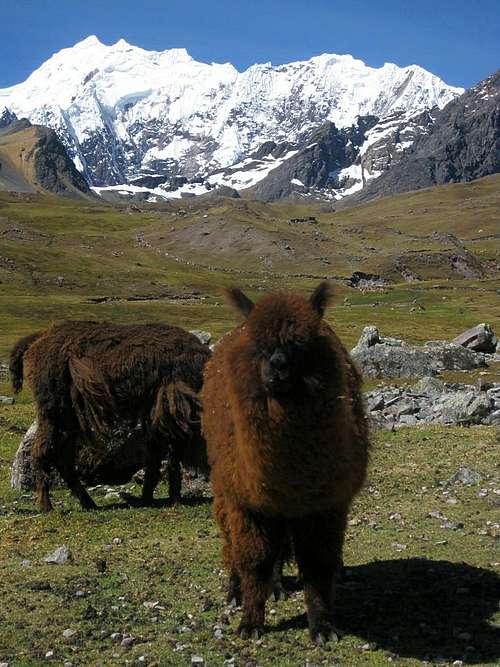
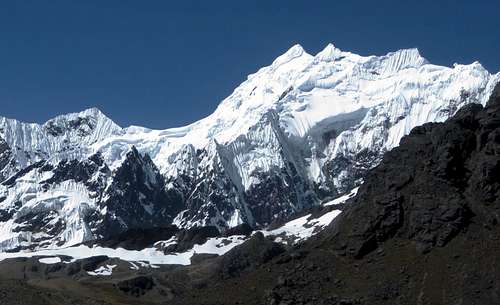

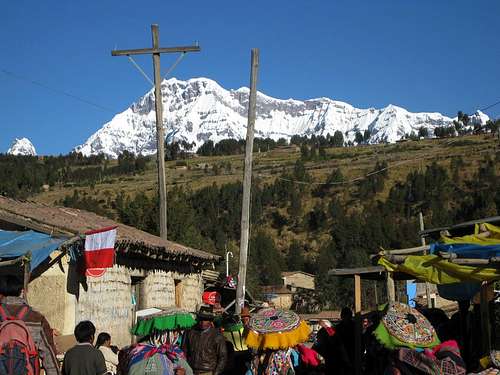
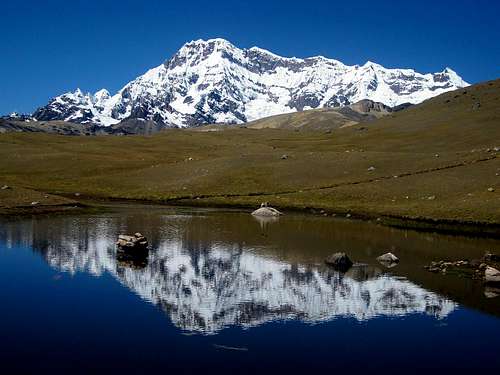




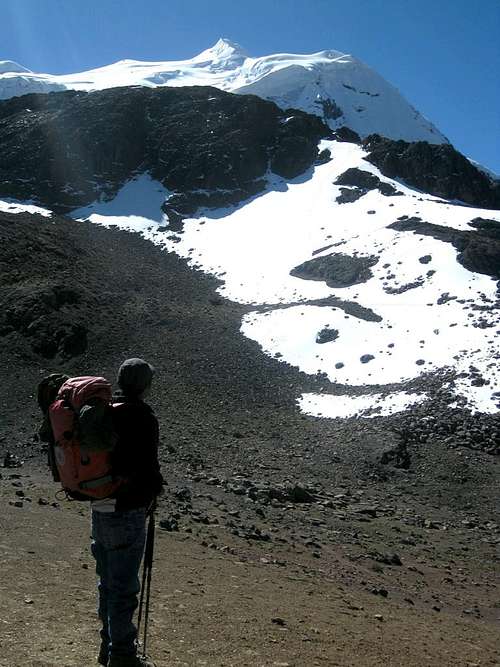



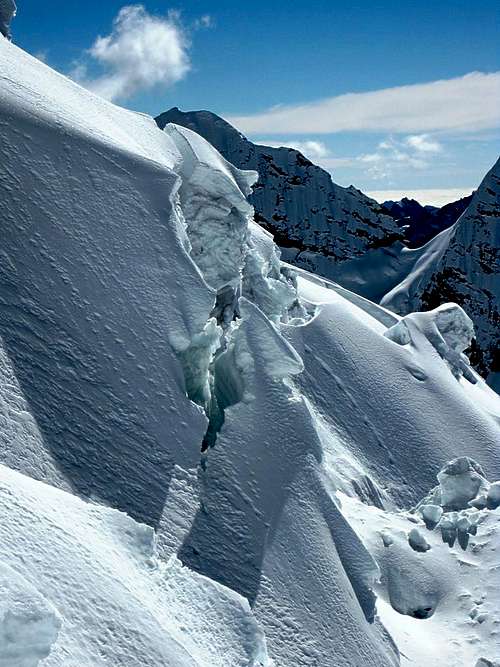


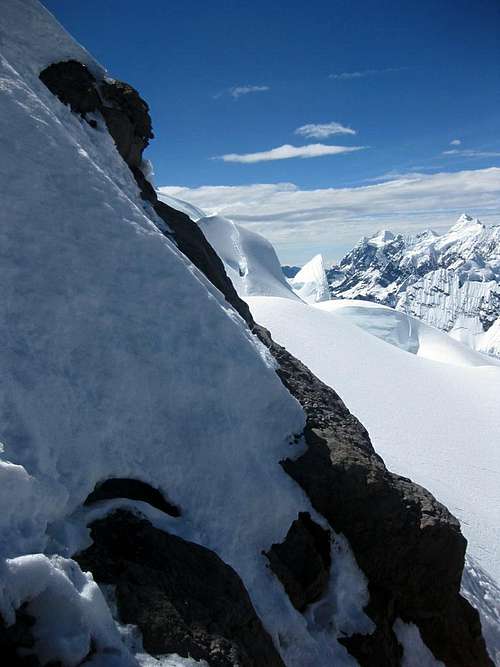

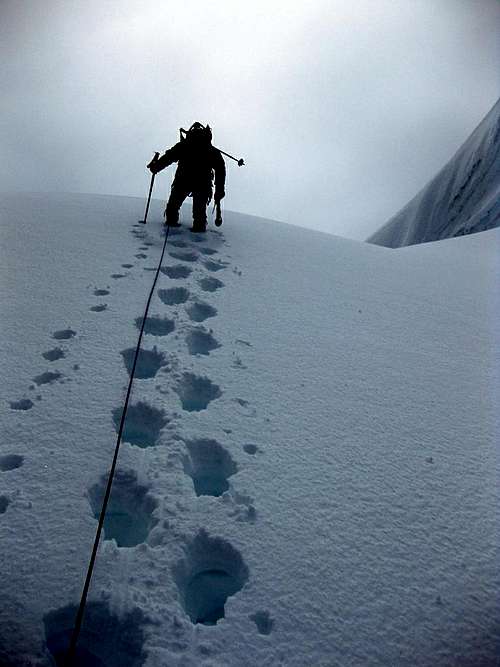

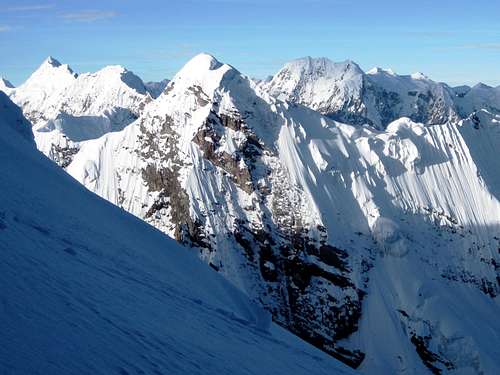
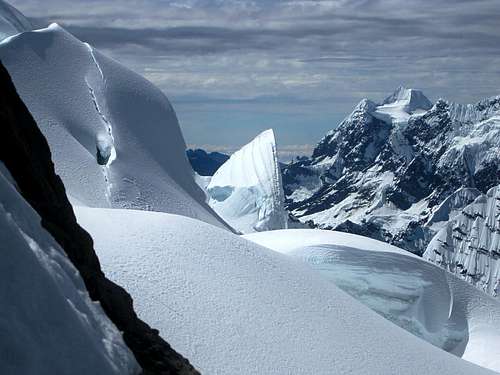






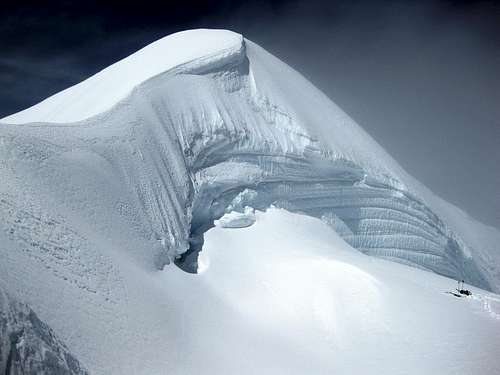
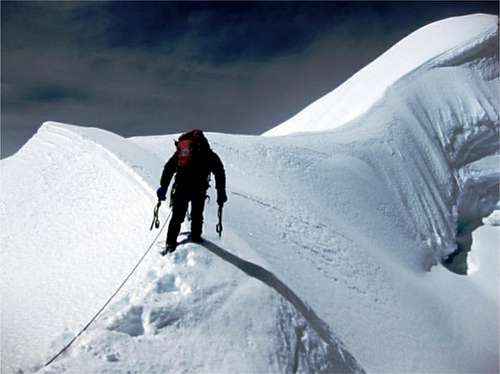


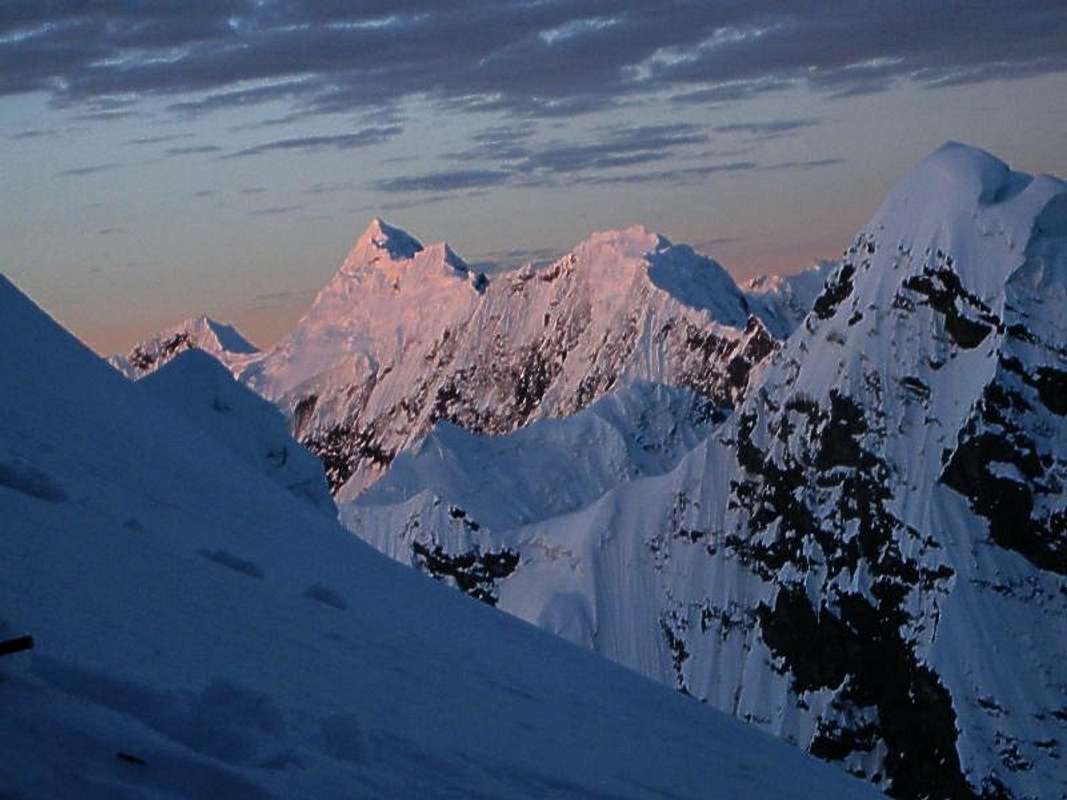
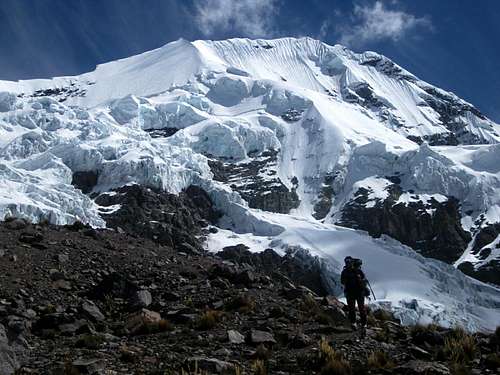
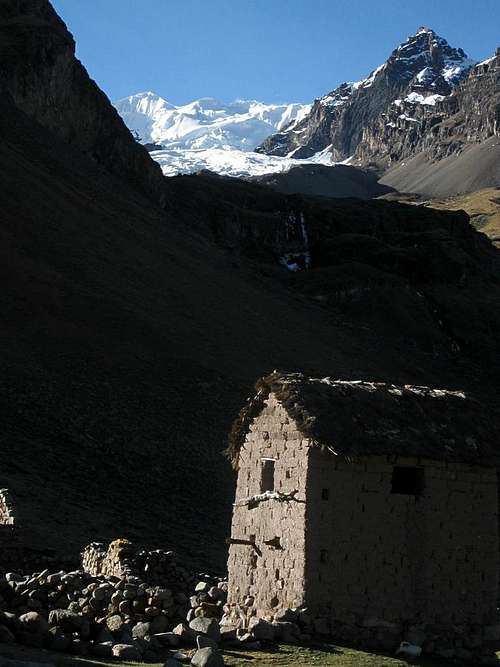
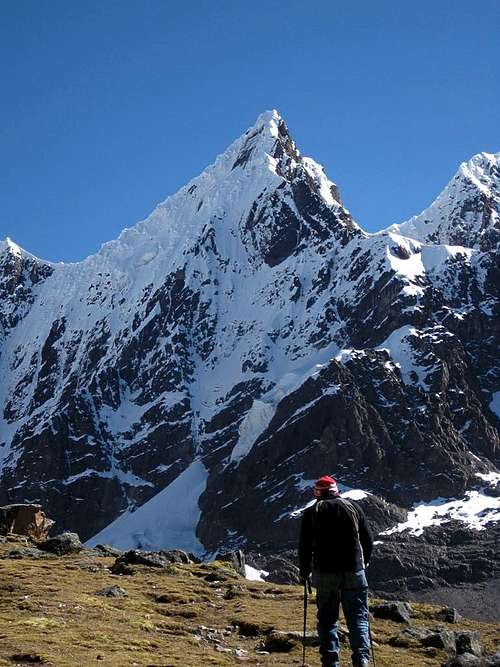
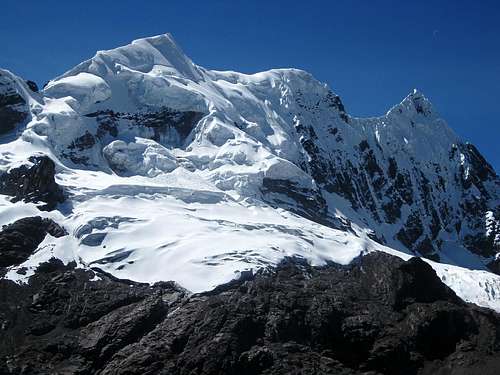
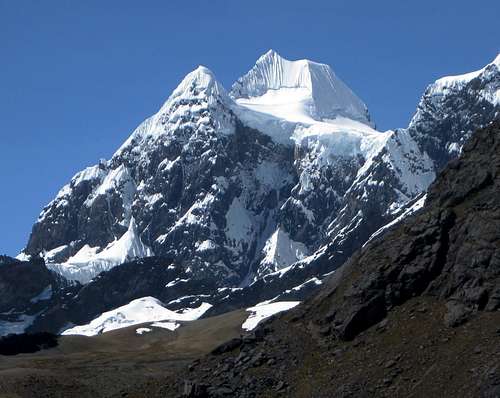









Comments
Post a Comment